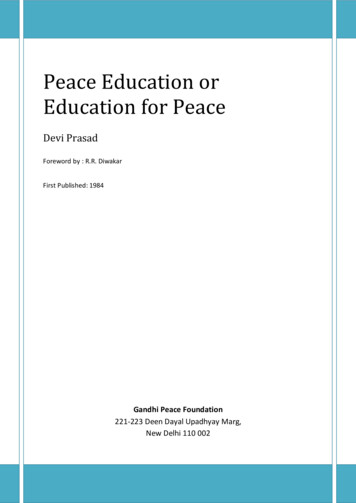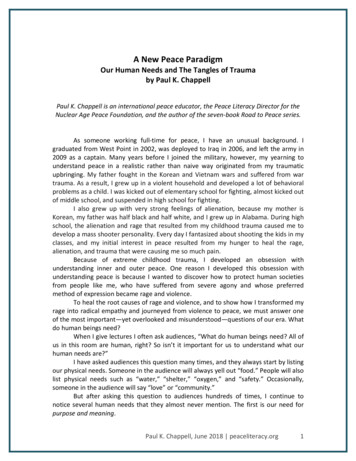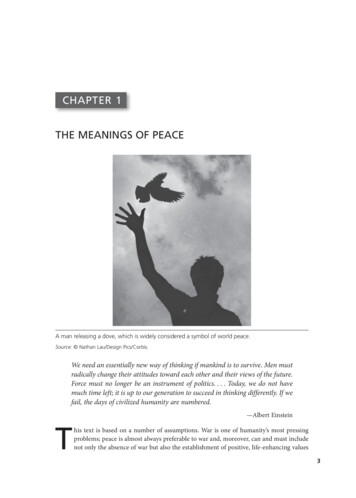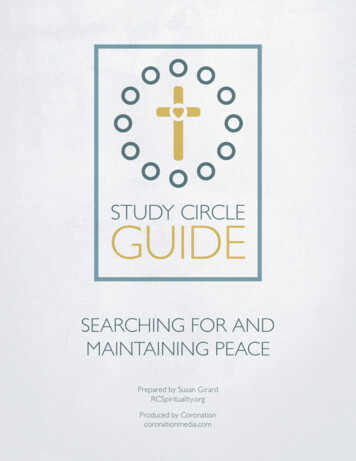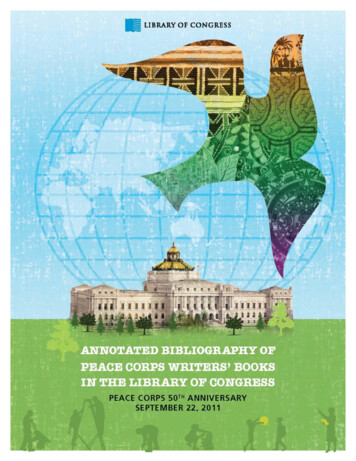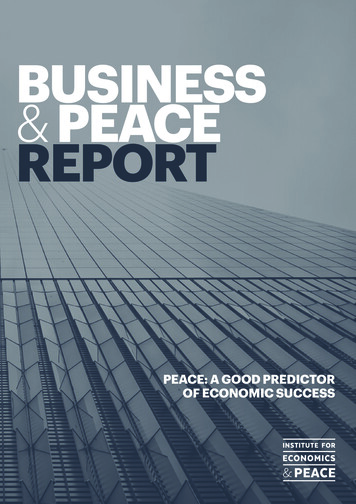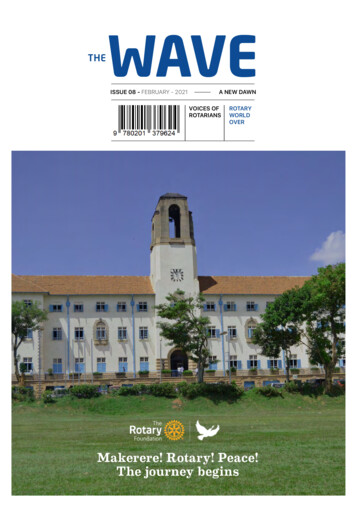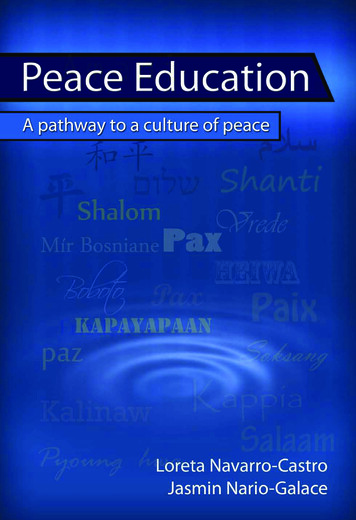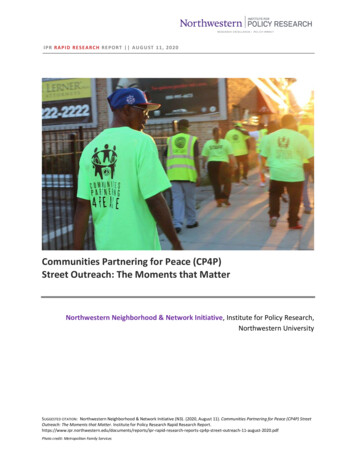
Transcription
IPRREPORT AUGUST 11, 2020Communities Partnering for Peace (CP4P)Street Outreach: The Moments that MatterNorthwestern Neighborhood & Network Initiative, Institute for Policy Research,Northwestern UniversitySUGGESTED CITATION: Northwestern Neighborhood & Network Initiative (N3). (2020, August 11). Communities Partnering for Peace (CP4P) StreetOutreach: The Moments that Matter. Institute for Policy Research Rapid Research reach-11-august-2020.pdfPhoto credit: Metropolitan Family Services
Follow @IPRatNU www.ipr.northwestern.eduIPRREPORT AUGUST 11, 2020“Communities Partnering for Peace (CP4P) Street Outreach:The Moments that Matter”by the Northwestern Neighborhood & Network Initiative (N3) at the Institute forPolicy Research, Northwestern UniversityBackground and ContextCommunities Partnering 4 Peace (CP4P) is a collaboration of Chicago street outreach organizations workingtowards a common goal: reducing gun violence among individuals with high-risk and gang-involved individuals.CP4P uses a comprehensive, long-term approach that relies on street outreach workers to strengthenrelationships throughout their respective communities. They serve as front-line mediators in on-going disputesas well as providing direct social services like legal and restorative justice, employment support, and traumainformed behavioral health counseling towards individuals who have the highest likelihood of shooting or beingshot.Street outreach is a decades-old practice in ChicagoFigure 1. CP4P Communitiesand other cities around the country. It is a model ofviolence prevention that relies on “crediblemessengers” to form relationships with communitymembers at the highest risk of being victims orperpetrators of violence.1. AustinThe credible messengers are typically well-respectedand well-connected community members and2. Humboldt Parkmentors who have lived experiences with gun3. West Garfield Parkviolence. Street outreach workers leverage4. East Garfield Parkrelationships within their networks to directlyintervene in conflicts that could escalate into5. North Lawndaleviolence, and work with their participants to find6. Little Village (South Lawndale)opportunities outside the world of street crime and7. Back of the Yards (New City)violence. The following research is focused on the8. West Englewood9. EnglewoodIPR N3 Report‚ 11 August 20201
Follow @IPRatNU www.ipr.northwestern.edueight original CP4P organizations that cover communities depicted in Figure 1.1As the research partner for CP4P, the Northwestern Neighborhood & Network Initiative (N3) uses quantitativeand qualitative methods to study its impact. A preliminary analysis of CP4P’s neighborhood-level impact onshootings and homicides found that shootings and homicides have decreased in CP4P communities since thelaunch of the programs in 2017. While analysis of administrative and survey data illuminates a wide range ofbehaviors and outcomes, they cannot fully describe the full spectrum of potential participant outcomes.Therefore, CP4P and N3 launched a qualitative study to provide a more holistic account of participant’s lives andexperiences with street outreach. This study enriches our understanding of how and why certain programelements work. Working together, CP4P and N3 developed a set of four questions to explore in a series of focusgroups and interviews with outreach participants:1. What influence, if any, does street outreach have on participant mindset, values, and perceptions?2. What influence, if any, does street outreach have on participants’ integration into their localcommunities?3. How do participants measure progress and define success and failure?4. What outreach interactions matter more or less to participants?This rapid research report is based on findings from this fourth research question. We examined participants’descriptions of street outreach in the context of the life experiences and changes they reported before, during,and after working with a CP4P organization. Findings are based on 16 interviews with CP4P participants and 16focus groups, each one with between five and ten CP4P participants. The interviews were conducted withparticipants from the eight originally funded CP4P organizations. The research and interview questions weredesigned jointly, though an engaged research process between N3 and CP4P organizations. An N3 researcherand outreach worker co-facilitated each interview and focus group, asking participants about their lifeexperiences, interactions with outreach, challenges, and successes. To further identify impactful interactionswith outreach workers, we also constructed a journey map for each interview based on participants’ narrativesof their experiences. Six types of key interactions with outreach emerged from our analysis of the interview andfocus group data and journey mapping; the mapping depicts a chronology of significant life events and how theyalign with outreach interactions.21. The original eight CP4P organizations are the Institute for Nonviolence Chicago (INVC), Alliance of Local Service Organizations (ALSO), Breakthrough,UCAN, New Life Centers, Precious Blood Ministry of Reconciliation, Inner-City Muslim Action Network (IMAN), and Target Area Development Corp.2. Two N3 research analysts created “journey maps” for each interview participant. These maps involve coding interview transcripts for the discreteevents, emotional experiences, mindsets, behaviors, and interactions with outreach as reported by participants. The maps established a chronology toexamine how significant life events and changes lined up with outreach interactions.IPR N3 Report‚ 11 August 20202
Follow @IPRatNU www.ipr.northwestern.eduParticipants Share Why Outreach MattersDuring interviews, CP4P participants described their outreach workers as heroes, mentors, and surrogate family.There are six types of interactions that outreach participants said mattered to them the most. The sixinteractions fall into two general areas of assistance for participants:1. Emotional coping and support, and2. Resources and opportunities.3Emotional Coping and SupportChicago outreach workers offer emotional support and coaching to their mentees as they go through crises andthe trials of everyday life.Offering Help During Dark Times Participants described in detail how their outreach workers offered support during life’s greatestchallenges—“my lowest point.” Rather than waiting to hear from participants in crisis, outreachworkers proactively reached out when informed of violence or other challenging incidents. Other particularly impactful outreach actions during participant crises were: outreach workers’modeling of spiritual wellness, conflict mediation, and consistent follow-up.Responding with Consistent Intervention While outreach workers often respond to crises, their more mundane engagements don’t gounnoticed by community members. Participants perceive their outreach workers as “alwaysthere”; this commitment at times extends, willingly, into outreach workers’ off hours, whichserves as powerful evidence of sincerity to participants. Participants cited outreach workers’ persistence as a key reason why they embraced violenceprevention and other related programming. Shifts in mindset were also reported, particularlyrelated to motivation, stress tolerance and reducing impulsivity.3. All icons are from The Noun Project. Credits: “Handshake” by Misha Petrishchev; “Phone” by Markus, NO; “Friendship” by Symbolon; “Briefcase”by Template; “Courthouse” by Corpus Delicti; “Help” by Adrien Coquet, FR.IPR N3 Report‚ 11 August 20203
Follow @IPRatNU www.ipr.northwestern.eduServing as Positive Mentors Outreach workers serve as many participants’ entry into and foundation of new, healthierrelationships. Participants appreciated these new social networks characterized by perceivedsafety and “positive energy.” By connecting participants to a like-minded peer group, outreach workers help participants toincrease their goal-setting and improve their self-images.Resources and OpportunitiesChicago outreach workers also open doors for their mentees, connecting them to resources and newexperiences related to employment, education, arts, and civic engagement.Providing Social Services and Recreation Leveraging their own personal and professional networks, outreach workers are able toconnect residents to previously untapped resources in their communities. Offerings range from a longer-term scope (employment, education, housing) to a situationalone (food assistance, transportation, etc.). Several participants mentioned that they had“never dreamed” of certain accomplishments they would come to achieve through theoutreach programming.Offering Legal Support Outreach workers’ roles often include advocating for participants navigating the criminallegal system. This includes attending participant court hearings, sharing participant progresswith parole/probation officers, and visiting incarcerated program participants. Legal support is at times the context through which participants first meet their outreachworkers. During interviews, some of them reflected on how outreach workerencouragement at this stage contributed to their success later on.Promoting Community Service Typically, outreach workers are influential and embedded community members whosepersonal stories model transformative change for others. Several participants discussed how their admiration for outreach workers motivated themto “give back.” Participants described contributions to local anti-violence efforts, likeFlatlining Violence Inspires Peace (FLIP) in vivid detail.IPR N3 Report‚ 11 August 20204
Follow @IPRatNU www.ipr.northwestern.eduBelow, we highlight the story of one participant from Chicago’s West Side, drawn from his own words and hisjourney map. It illustrates how outreach workers form relationships, work with participants, and describe theprogram’s impact on participants’ lives.Maurice’s StoryMost days Maurice4 wakes up with his heart racing. He takes the bad memories that revisit him at night, noteshis thoughts in his phone, and gets along with his day.After dropping out of high school at 18, Maurice spent most of his time either on the streets trying to makemoney or hanging out with his friends trying to stay safe. Maurice took risks, but he also worried about hissafety. At 20, he had already lost too many friends. At that time in his life, Maurice always tried to find the fun,but gave little thought to where he was going. He said, “I’m the type that I really don’t care about much. I reallywouldn’t even care sometimes if my mom wouldn’t like it. I’m like, ‘I’m grown. I do me. She’s just going to haveto get used to the stuff I do. ’ ”So far, Maurice has avoided jail, but he did not see his life going anywhere. He did not believe he couldaccomplish much of anything.“I’m the type that I really don’t care about much. I really wouldn’teven care sometimes if my mom wouldn’t like it. I’m like, ‘I’mgrown. I do me. She’s just going to have to get used to the stuffI do.’ ” –Maurice, CP4P Participant“The jump” happened while Maurice was hanging out someone he thought was a close friend. He doesn’tremember being attacked, only waking up in the hospital, his head swollen. A doctor told him the attack hadshifted his brain to the left. Maurice had to relearn all the basics of life, from understanding his name to walking.As he recovered physically, Maurice learned that the group of men that assaulted him were childhood friends.Distrust, anxiety, depression, and post-traumatic stress disorder (PTSD) set in.A month or two later, Maurice remembers meeting Trey, anoutreach worker from one of the CP4P organizations. It wasHelp during dark timesactually the second time they had met: Trey had visited Mauricewhile he was in the hospital, but this was the first time Maurice remembers the two meeting. Trey offered toconnect Maurice with services to help him move his life forward.4.All names in this story have been changed to protect participants’ privacy.IPR N3 Report‚ 11 August 20205
Follow @IPRatNU www.ipr.northwestern.eduMaurice was ready to accept the offer, but he was skeptical that anything could make a difference in his life.“When I first came in [to the CP4P organization], I’ll tell them straight up I didn’t think it was going to help,” hesaid. “I still came in with an attitude like, ‘I don’t give a f*** about this.’ ”Maurice’s skepticism did not dissuade Trey, and it did not stop Maurice from trying out one of the organization’sprograms that involved his passion, music.A couple of years before, Maurice, as he recalls, “did a quick verse” [rapped a few verses] while smoking andjoking with friends—rapping seemed to come naturally to him. After testing the waters and encouraged by hisfriends, Maurice stopped smoking and drinking to up his musical game. Using an old laptop, he started layingdown beats, verses, and tracks. Since then Maurice has stayed sober to keep his mind clear to make music.The first formal program Trey got Maurice into built on his passionSocial services and recreationfor music, focusing on art and music, setting up equipment, andlearning about music production.Maurice, however, will be the first to admit that it wasn’t the music that brought him in the door, but thestipend. When the program and the stipend ended, Maurice got a different job. But he kept coming back to theprogram. The music and the camaraderie with other participants had won him over. In addition to the music,Maurice talked about the program’s discussion circles, where participants could talk about their days and theirlives. He described people as quiet in these circles at first. Then, outreach participants cautiously started toshare “like a turtle coming out with the little neck.” They opened up about their pasts and their experiences intheir neighborhoods. Maurice never expected to have that type of emotional experience or leave the programwith friends who felt like family.“It was a lot of learning to be around other young men coming from the same struggles as me and this positiveenergy,” Maurice said. “[B]efore the program, everybody talked about killing and guns. They open doors thatwas locked, that we didn’t know how to open.”“It was a lot of learning to be around other young men coming from thesame struggles as me and this positive energy. [B]efore the program,everybody talked about killing and guns. They open doors that was locked,that we didn’t know how to open.”–Maurice, CP4P ParticipantMaurice had learned to expect people to let him down, but outreach showed up for him on and off the clock. InTrey and the other outreach workers, Maurice found people who would lift him up in saying, “I’m not going togive up on you,” and “I know you have this potential.”IPR N3 Report‚ 11 August 20206
Follow @IPRatNU www.ipr.northwestern.eduMaurice says having someone to push him made the differencebetween a positive and negative mindset. He is trying to get his GED,Consistent interventionbut he failed math on his first try and quit. Trey didn’t let him off thehook. According to Maurice, “He was just like ‘Why? What happened,Positive mentorshiplittle brother? Go back in and you could be ready for it. Don’t justgive up like that. You can do it. I know you can do it.’ ” That’s notalways what Maurice wants to hear, but he doesn’t want to let Trey down. So he’s giving the GED programanother try.Maurice still wakes up with panic attacks, his heart racing as he jumps out of bed, but Trey connected him with acounselor for that. Maurice still doesn’t know exactly what his future will look like or if he can make money offof music, but he’s hopeful and is at peace with his direction. “Music is my passion, yes, I love music, but I got tomake sure my family is straight,” he said. “If I can do it with the music, I’ll do it, but if I can’t, but there’s anotherway. Let’s get it.”Maurice has plans A, B, and C for what that job could be and how to keep pushing himself further and further:Back to school. To college. To possibilities he never saw for himself before.“When I was really down, they came through. They showed as much love as theycould. I appreciated that because it could be rough times. It could be good days,bad days, lost friends. Other times, you think nobody is on the side of you.While you [are] sitting there shedding tears, they would always call.”–Maurice, CP4P Participant--IPR N3 Report‚ 11 August 20207
Follow @IPRatNU www.ipr.northwestern.eduThe Northwestern Neighborhood & Network Initiative (N3) promotes new ways for faculty, experts, andstudents at Northwestern University’s Institute for Policy Research to engage communities, civic partners,and policymakers to address core problems facing the residents of Chicago and surrounding communities.Specific projects and types of engagement will be linked by a focus on how the social relationships amongnetworks, geographic communities, and the constellation of groups, organizations, and civic partners affectwhat we feel, think, and do—and how understanding, building, and leveraging this sort of network-thinkingcan improve neighborhoods, the city, and our region.N3 Report Contributors:Rose Werth, Graduate Research FellowDallas Wright, Research Study CoordinatorDawna Goens Leggett, Senior Research ManagerSoledad McGrath, Executive Director and IPR Research ProfessorAndrew Papachristos, Faculty Director, Professor of Sociology, and IPR FellowFor more information about this report or N3, please contact Andrew Papachristos at avp@northwestern.edu.Follow N3 on Twitter @N3Initiative.This research and evaluation are made possible with support from the Joyce Foundation,Pritzker Pucker Family Foundation, Chicago CRED, and the Partnership for Safe and Peaceful Communities.IPR N3 Report‚ 11 August 20208
Aug 11, 2020 · Communities Partnering 4 Peace (CP4P) is a collaboration of Chicago street outreach organizations working . UCAN, New Life Centers, Precious Blood Ministry of Reconciliation, Inner-City Muslim Action Network (IMAN), and Target Area Development Corp. 2. . Outreach workers serve as many participants ent
